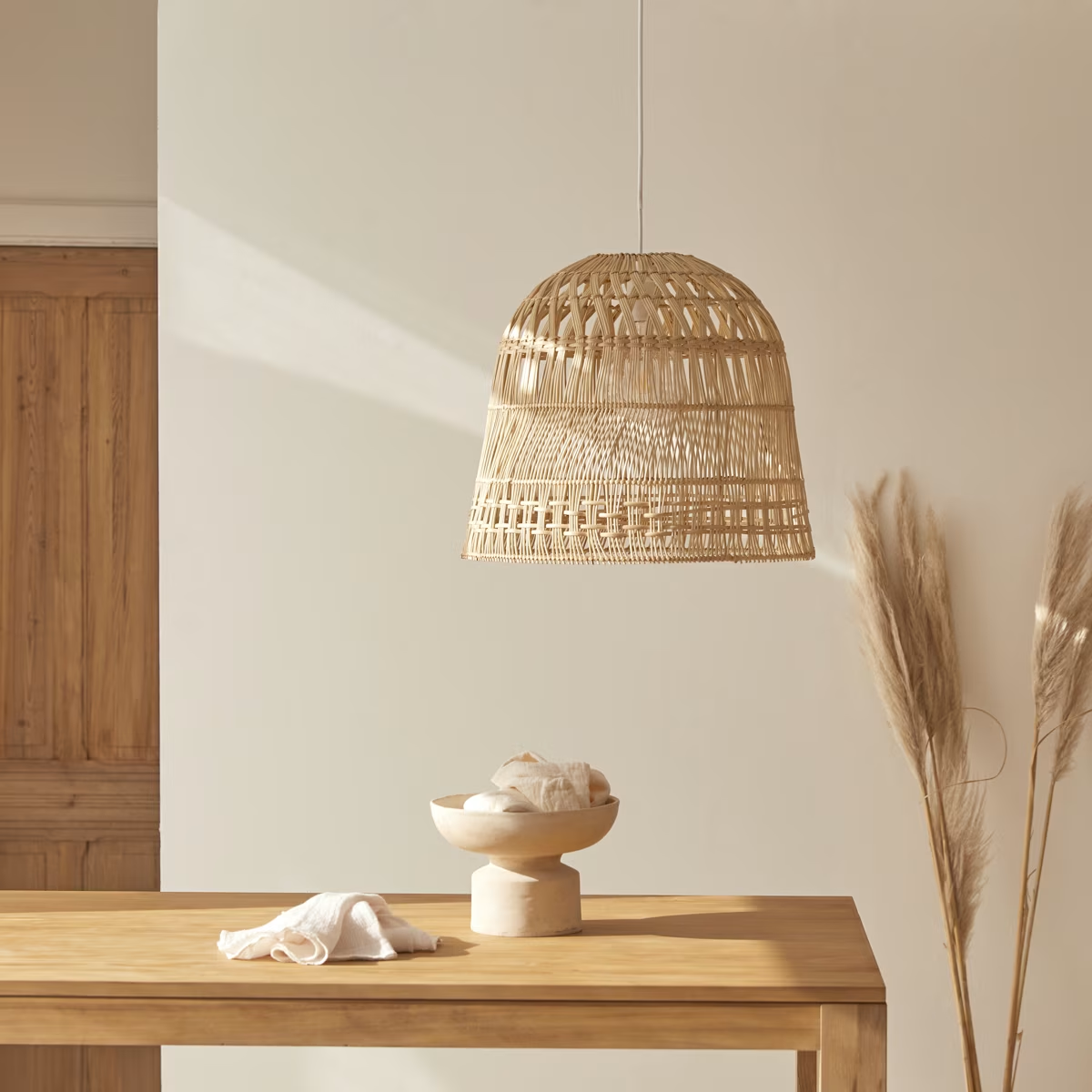Choose the right rattan material by evaluating weave density, fiber quality, and moisture resistance ratings. Consider natural rattan for authentic character and optimal light diffusion, ensuring proper thickness for structural integrity. Select species-appropriate treatments and finishes while matching weave patterns to intended room function and lighting requirements.
Choosing the right rattan material transforms your lighting from mere functionality into an extraordinary artistic statement. As a sustainable lighting enthusiast at Lighting a Greener Future, I’ve witnessed countless spaces illuminated by the magical interplay of light through natural rattan weaves. The journey of selecting the perfect rattan material is like choosing a fine musical instrument – each piece has its unique voice and character.
Understanding Rattan Material Fundamentals
The journey to perfect rattan lighting begins with understanding its essence. According to the International Network for Bamboo and Rattan, over 600 species of rattan exist worldwide, each with distinct characteristics that influence their suitability for lighting applications.
Natural vs Synthetic Rattan Properties
Natural rattan brings unmatched character. Its solid core and flexible outer skin create a perfect harmony of strength and beauty. The material breathes life into any space, creating an organic connection between light and shadow.

When comparing natural and synthetic options, consider these essential factors:
- Tensile strength varies significantly between species
- Natural rattan offers superior fiber density and authentic charm
- Synthetic alternatives provide consistent surface texture
- Each type requires different moisture resistance considerations
I strongly believe that synthetic rattan, despite its practicality, can never replicate the soul-stirring warmth of natural rattan fibers. The aging process only enhances its character, like fine wine developing complex notes over time.
Quality Indicators for Authentic Rattan
Look for tight, even weaves and smooth, consistent finishes. A quality piece should feel substantial yet light. The Natural Fiber Council emphasizes several key indicators:
The core material should demonstrate:
- Uniform coloration without artificial dyes
- Consistent diameter throughout
- Smooth transitions at joints
- Natural luster without artificial glazes
- Flexibility without brittleness
Think of these indicators as the fingerprints of authentic rattan. Each piece tells its own story through subtle variations and natural patterns.
Common Misconceptions About Rattan Durability
Many assume all rattan is weather-resistant. The truth? Natural rattan requires indoor protection from moisture and direct sunlight. Think of it as a delicate instrument that needs proper care to maintain its perfect pitch.
Common myths include:
- All rattan is suitable for outdoor use
- Natural and synthetic rattan require identical care
- Higher price always indicates better quality
- All rattan species offer equal durability
- Traditional treatments guarantee longevity
Contrary to popular belief, I’ve found that some of the most affordable rattan pieces, when properly selected and maintained, outlast their premium counterparts.
Have you ever wondered why some rattan pieces last generations while others deteriorate quickly?
How to Choose the Right Rattan Material
The selection process demands both technical knowledge and artistic sensitivity. The Sustainable Rattan Initiative reports that 80% of quality rattan materials originate from Indonesia, making it the epicenter of premium rattan production.
Evaluating Rattan Weave Patterns and Textures
The interplay between light and weave creates the soul of your pendant lamp. Consider how different patterns affect illumination:
| Weave Type | Light Diffusion | Best Application | Maintenance Level | Visual Impact |
|---|---|---|---|---|
| Tight Weave | Subtle, focused | Task lighting | Moderate | Sophisticated |
| Medium Weave | Balanced | All-purpose | Low | Versatile |
| Loose Weave | Dramatic shadows | Ambient lighting | High | Dynamic |
| Diamond Weave | Complex patterns | Feature lighting | Medium | Artistic |
| Spiral Weave | Directional glow | Accent lighting | High | Contemporary |
Assessing Material Thickness and Flexibility
The relationship between thickness and flexibility determines both durability and design potential. Consider these crucial factors:
Physical Properties:
- Tensile strength for durability
- Fiber density for structure
- Surface texture for aesthetic appeal
- Moisture resistance for longevity
- Visual texture for design impact
When evaluating flexibility, remember that proper rattan-weaving techniques should allow for natural movement without compromising structural integrity.
Understanding Color Variations and Finishes
Natural variations in color create unique character. Each piece tells its own story through subtle tone differences and grain patterns. The aging process brings:
- Deepening of natural honey tones
- Development of rich patinas
- Enhanced grain visibility
- Subtle color variations
- Character-adding markings
The Indonesian Rattan Association emphasizes that these variations are hallmarks of authentic materials, not flaws.
Material Selection Based on Room Purpose
Understanding your space’s needs guides material selection. Consider how light-filtering properties affect different environments:
Living Areas:
- Looser weaves create relaxing ambient light
- Natural color variations add warmth
- Sustainable material choice enhances eco-conscious design
Dining Spaces:
- Medium-density weaves provide ideal task lighting
- Handcrafted pendant lights create intimate atmospheres
- Structured patterns complement formal settings
What story do you want your lighting to tell in each room?
Design and Aesthetic Considerations
The aesthetic appeal of rattan extends beyond mere decoration. Natural rattan can reduce energy consumption by up to 80% when paired with LED bulbs. This fusion of beauty and efficiency exemplifies modern sustainable design.
Matching Rattan Styles with Interior Themes
Light-filtering properties create an enchanting ambiance. The Natural Fiber Council emphasizes these style-matching principles:
Contemporary Spaces:
- Clean-lined weave patterns
- Minimal color variation
- Weather-resistant treatments
- Geometric designs
- Modern finishing techniques
Traditional Settings:
- Complex weave interpretations
- Rich natural tones
- Authentic rattan texture
- Heritage patterns
- Artisanal craftsmanship
Size and Scale Guidelines for Different Spaces
A pendant light’s scale should complement its environment. The whole determines the parts – from the rattan stem to the woven shade. Consider these proportional relationships:
Small Spaces (Under 100 sq ft):
- 14-18 inch diameter fixtures
- Lighter weave density
- Proportional height ratios
- Balanced visual weight
- Space-appropriate designs
Large Areas (Over 200 sq ft):
- 24-36 inch diameter options
- Dramatic weave patterns
- Statement-making scales
- Layered lighting effects
- Bold architectural elements
Light Diffusion Properties of Various Weaves
The interaction between light and rattan creates magical effects. Calamus Rotang, known for its superior properties, demonstrates exceptional light-diffusing characteristics:
- Shadow patterns vary with weave density
- Natural fibers create warm light tones
- Layered weaves produce depth
- Pattern complexity affects ambiance
- Distance impacts light spread
Technical Specifications and Requirements
Proper technical understanding ensures optimal performance and longevity. The natural-fiber composition of rattan demands specific consideration for installation and maintenance.
Optimal Bulb Types for Rattan Pendants
LED technology revolutionizes rattan lighting design:
Temperature Management:
- Maximum 40W equivalent LED bulbs
- Color temperature 2700K-3000K
- Heat dissipation requirements
- Dimming compatibility
- Light distribution patterns
Weight and Support Considerations
Durability rating matters for safe installation. Consider both the core material and outer skin when evaluating structural integrity:
Installation Requirements:
- Support capacity minimum 25 pounds
- Proper junction box mounting
- Weight distribution analysis
- Balance point calculation
- Safety factor considerations
Ventilation and Heat Management
Proper airflow prevents heat damage. Natural-fiber materials need breathing room:
Ventilation Guidelines:
- Minimum 6-inch clearance above fixture
- Air circulation patterns
- Heat rise calculations
- Moisture control measures
- Temperature monitoring recommendations
Weather Resistance Requirements
Though primarily indoor fixtures, environmental factors affect longevity:
- Humidity control measures
- UV exposure limitations
- Temperature fluctuation tolerance
- Air quality considerations
- Seasonal adjustment needs
Maintenance and Longevity
Maintaining rattan lighting requires understanding its nature. Authentic rattan texture responds differently to environmental factors than synthetic alternatives.
Cleaning and Care Instructions
Gentle cleaning preserves the natural rattan weave. Develop a maintenance routine:
Daily Care:
- Light dusting with soft brush
- Air circulation checks
- Visual inspection for damage
- Moisture level monitoring
- Basic structural assessment
Monthly Maintenance:
- Deep cleaning with natural solutions
- Tensile strength testing
- Weave pattern inspection
- Joint stability checks
- Protective treatment assessment
Moisture Control Methods
I challenge the common practice of treating all rattan with heavy sealants. Sometimes, allowing the material to breathe naturally extends its lifespan. The Indonesian Rattan Association recommends:
Humidity Management:
- Maintain 40-60% relative humidity
- Use dehumidifiers when needed
- Monitor seasonal changes
- Implement moisture barriers
- Regular ventilation assessment
UV Protection Strategies
Strategic placement away from direct sunlight preserves the sustainable material choice. Consider:
Protection Methods:
- UV-filtering window films
- Strategic fixture positioning
- Rotating exposure patterns
- Seasonal placement adjustments
- Protective coating maintenance
Signs of Quality Deterioration
Learn to recognize early warning signs:
- Color inconsistencies
- Weave loosening
- Joint weakness
- Surface brittleness
- Structural changes
Beyond Traditional Applications
Innovation drives the future of rattan lighting design. Calamus Rotang, the premium rattan species, continues to inspire new applications. Natural rattan can achieve extraordinary design feats while maintaining its eco-friendly essence.
Innovative Rattan Lighting Technologies
The fusion of traditional craftsmanship with modern technology creates extraordinary possibilities. Rattan-weaving techniques evolve while honoring ancestral wisdom:
Modern Innovations:
- Smart lighting integration
- Color-changing LED compatibility
- Motion-sensitive controls
- Automated maintenance monitoring
- Environmental response systems
Custom Design Possibilities and Modifications
Personalization options abound. From weave pattern to overall design, each element can be tailored to your vision:
Customization Options:
- Pattern combinations
- Size modifications
- Finish variations
- Structure adaptations
- Lighting effect customization
Have you considered how custom modifications might enhance your space’s unique character?
Looking to the Future
The future of rattan lighting combines tradition with innovation. The Sustainable Rattan Initiative predicts exciting developments:
Emerging Trends:
- Bioengineered rattan varieties
- Advanced preservation techniques
- Hybrid material combinations
- Smart material integration
- Sustainable harvesting innovations
The journey of choosing the right rattan material for your pendant light is both an art and a science. When done thoughtfully, it creates not just illumination, but an enchanting atmosphere that transforms any space into something truly special.
Remember that each rattan pendant light tells a unique story through its natural rattan weave, creating a dialogue between light, shadow, and space. The key lies in selecting materials that align with both your practical needs and aesthetic vision while honoring the sustainable legacy of this remarkable natural resource.
What possibilities will you discover in your rattan lighting journey?
FAQ:
How does rattan’s cellular structure affect its light-diffusing properties?
The microporous nature of natural rattan fibers creates subtle light diffraction, resulting in a warm, organic illumination pattern unique to each weave density.
What are the specific weight limitations for different rattan species in pendant lights?
Manau rattan supports up to 25 pounds for pendant fixtures, while smaller species like Sega rattan should be limited to 15 pounds for safety.
How do seasonal changes impact rattan material performance?
Natural rattan expands and contracts with humidity fluctuations, requiring 40-60% relative humidity maintenance and quarterly structural assessments.
Which finishing techniques best preserve rattan’s natural properties?
Water-based sealants with UV inhibitors maintain rattan’s flexibility while protecting against environmental damage and premature aging.
Can rattan be effectively combined with other materials in pendant lighting?
Rattan harmonizes well with brass, copper, and natural wood elements, provided proper joining techniques and weight distribution are considered.


